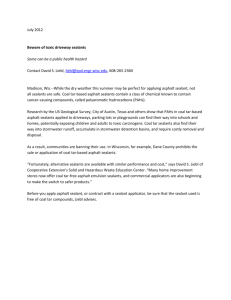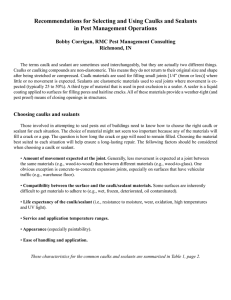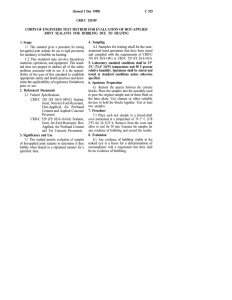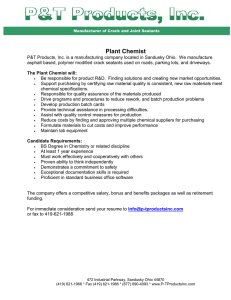glazing systems specifications manual
advertisement
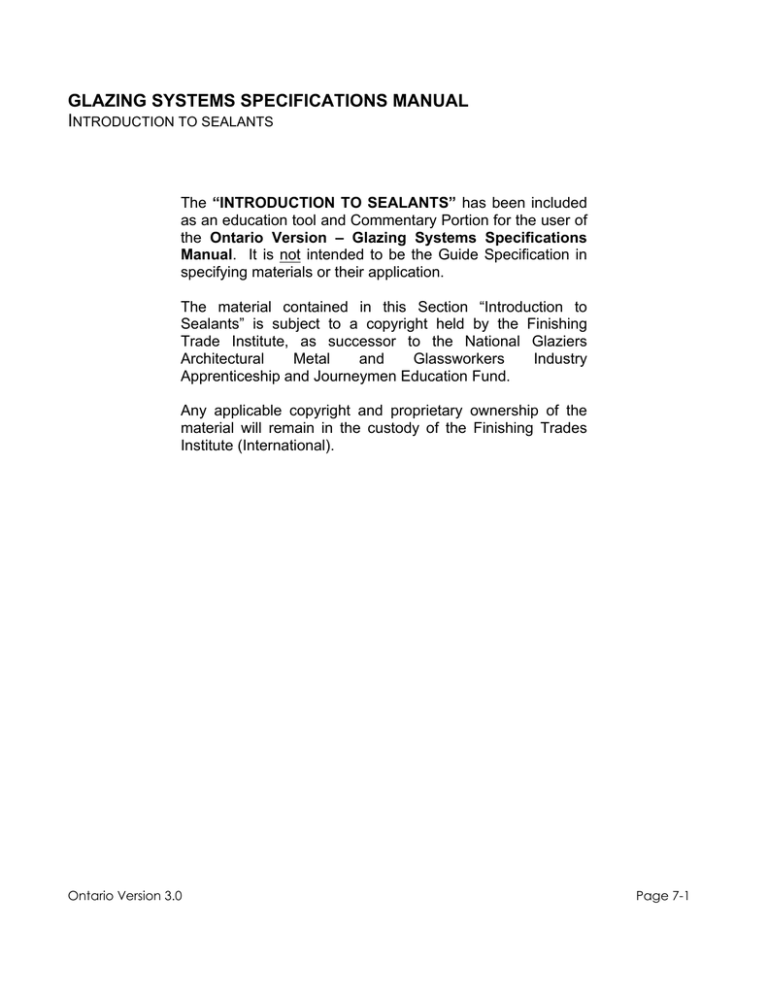
GLAZING SYSTEMS SPECIFICATIONS MANUAL INTRODUCTION TO SEALANTS The “INTRODUCTION TO SEALANTS” has been included as an education tool and Commentary Portion for the user of the Ontario Version – Glazing Systems Specifications Manual. It is not intended to be the Guide Specification in specifying materials or their application. The material contained in this Section “Introduction to Sealants” is subject to a copyright held by the Finishing Trade Institute, as successor to the National Glaziers Architectural Metal and Glassworkers Industry Apprenticeship and Journeymen Education Fund. Any applicable copyright and proprietary ownership of the material will remain in the custody of the Finishing Trades Institute (International). Ontario Version 3.0 Page 7-1 GLAZING SYSTEMS SPECIFICATIONS MANUAL INTRODUCTION TO SEALANTS The real evolution in sealants began during the Second World War. In the 1940’s, the use of aluminum curtain wall dictated the need for a variety of new sealant materials. A wide variety of construction sealants have since been developed to meet the requirements of modern building materials, construction methods, and design concepts. Sealants, in relation to the total expense of a building, are relatively minor. However, the function of the sealant is most important. Joint movement is a very important factor in sealant selection. If the joint is static (fixed, non-moving, or non-working), it can be filled by almost any sealant. However, if the joint is dynamic (moving, expanding or contracting), sealants that cannot accommodate movement will fail. No one sealant is best for all types of joints and service conditions. Proper sealant selection depends on a combination of good joint design, the correct properties in sealants, and the proper installation and application procedures. Ontario Version 3.0 Page 7-2 GLAZING SYSTEMS SPECIFICATIONS MANUAL INTRODUCTION TO SEALANTS Glossary Since every glazier routinely uses sealants, knowledge of sealant related terms is imperative. The following glossary provides the definitions for many of the terms used in the glazing trade today. Accelerate – To hasten or quicken the natural progress or progress of a reaction or event. For example, the drying rate of an adhesive or sealer is hastened or accelerated by increasing the temperature. Activator / Catalyst – A material which, when added to a base compound or a curing agent (as in the case of a two-part sealant), will speed up or initiate the curing process. Adhesion – Adhesion refers to the ability of a sealant to adhere to a building substrate. Adhesion Failure – Adhesive failure occurs when a sealant pulls away from the surface or substrate to which it was bonded (see Figure 1). Possible causes of adhesive failure would include joint movement that exceeded the sealant’s capability, improper surface preparation, or improper bead configuration. figure 1 Ontario Version 3.0 Page 7-3 GLAZING SYSTEMS SPECIFICATIONS MANUAL INTRODUCTION TO SEALANTS Glossary (Continued) Adhesion Test The adhesion test is to be performed at the start and end of each production run or day. It will verify that the sealant adhesion has not changed from the beginning to the end of a production run, assuring consistent performance. The adhesion test is to be performed as follows: A. Clean both finished metal and glass substrates with the recommended cleaning procedures. B. Apply a bead of the silicone sealant to the substrates in used, approximately ½” wide, 3/8” high by 4” long. Tool the bead to ¼” thickness. C. Allow the sealant to cure for 24 hours at 77°F (25°C) or higher. D. Upon completion of the cure, undercut about 1” of the test bead at the substrate interface with a razor blade and pull this tab of sealant at 90° to the substrate. The sealant should tear cohesively with no adhesion loss. E. Record the results of adhesion in the project logbook. Note: If pull test results in adhesive failure (sealant pulling away neatly from the substrate, notify the Manufacturer immediately for direction. Ontario Version 3.0 Page 7-4 GLAZING SYSTEMS SPECIFICATIONS MANUAL INTRODUCTION TO SEALANTS Glossary (Continued) Air Curing – Vulcanization at ordinary room temperatures or without the aid of heat. Ambient Temperature – The environment temperature surrounding the object under construction. Back-Up – A material placed into a joint, primarily to control the depth of the sealant. Bead – The application of the sealant is referred to as the caulking or glazing bead. Bedding / Bed – Usually the first bead of compound to be applied when setting glass or panels. Bleeding – The absorption of oil from a compound into an adjacent porous surface. Bond Breaker – Tape or backer rod designed to prevent three sided sealant adhesion. Cap Bead –A bevelled surface designed to shed water away from the joint or glass. The cap bead becomes the primary line of defence against water and air penetration (see Figure 2). figure 2 Coefficient of Expansion – The amount a given material increases and decreases in size with temperature changes. Ontario Version 3.0 Page 7-5 GLAZING SYSTEMS SPECIFICATIONS MANUAL INTRODUCTION TO SEALANTS Glossary (Continued) Cohesion – The molecular attraction that holds the body of a sealant or adhesive together; the internal strength of an adhesive or sealant. Cohesion Failure – Cohesive failure occurs when the sealant fails to hold together. Cohesive failure can take the form of splits and tears in both transverse and longitudinal directions (see Figure 3). General causes of cohesive failure would include improper sealant selection, poor mixing of multi-component sealants, or possible air entrapment in the caulking gun. figure3 Compatible – The ability of two or more substances to mix or blend without separation or reaction. Cure Time – The length of time it takes for the sealant to reach full cure (generally from 7 to 21 days. Elastomer – An elastic or rubber like substance that may occur either naturally or synthetically. An elastomer substance can be stretched to at least twice its original length, and, after having the stress removed, returns to approximately its original length in a short time. Ontario Version 3.0 Page 7-6 GLAZING SYSTEMS SPECIFICATIONS MANUAL INTRODUCTION TO SEALANTS Glossary (Continued) Filler – A filler is a relatively non-adhesive substance that is added to a sealant to improve its working properties, performance, strength, or other qualities. Heel Bead – After the glass has been installed, a bead of sealant is used to bridge the joint between the glass and the sash or frame. This is a secondary line of defence against water penetration in a prime sealed window but in a rain screen window it becomes the primary seal. Heel beads should not be used unless the glazing cavity is drained. (see Figure 4). figure 4 Immersion – Placing into a fluid – generally until it is completely covered. Joints – A joint can be generally defined as the longitudinal or lateral opening that occurs when any two building surfaces meet. The two basic kinds of joints are: Static Joints – are fixed, non-moving, non-working joints not subject to extreme temperature changes. Dynamic – occur when two surfaces meet as in lap or butt situations. Dynamic joints must withstand the expansion and contraction movements of the building’s structure. Modulus – Refers to the ratio between stress and strain. Sealants are classified as either low, medium or high modulus; a low modulus material stretches easily. Ontario Version 3.0 Page 7-7 GLAZING SYSTEMS SPECIFICATIONS MANUAL INTRODUCTION TO SEALANTS Glossary (Continued) Non-Drying – A compound that does not “set-up” hard. Non-Skinning – A product that does not form a surface skin after application. It usually remains tacky or sticky.. One-Part Sealant – A chemically curing sealant containing a reactive polymer base which cures upon exposure to the air and/or humidity. It requires no mixing. Primer – A material applied to joint faces to improve the bond (adhesion) of sealants. Sight Line – The intersecting point of the glass and the framing system; the point where daylight begins. Skin Time – The time between the application of the sealant and when its surface forms a skin. Tooling must be done prior to skin time. Substrate – The surface to which a sealant is applied and must bond. Tack Free Time – Tack free time refers to the time from sealant application to when it cures to a point where it no longer sticks to a finger. At tack free time, a sealant bead will no longer pick-up construction dirt and debris. Tear Strength – The load required to tear apart a sealant specimen (expressed in pounds). Toe Bead – A bead of sealant placed between a gasket or extruded glazing tape and the sash or glazing. The bead must be large enough to contact the edge of the glass after setting. Like the heel bead, this is a secondary line of defence against water and air penetration (see Figure 5). figure 5 Ontario Version 3.0 Page 7-8 GLAZING SYSTEMS SPECIFICATIONS MANUAL INTRODUCTION TO SEALANTS Glossary (Continued) Tooling/Striking Off – To force a material against the backing and the surfaces of a joint to provide a smooth finished look and to provide better adhesion to the substrate. Tooling Time – The amount of time a glazier has from sealant application to properly tool the sealant prior to its skin time. Two-Part Sealant – A product supplied in two separate parts; one containing the reactive polymer base and the other the catalyst or activator. The two components are thoroughly mixed just prior to using since its’ work like is limited.. United Inches – The sum of the dimensions of one length and one width of a lite of glass. Viscosity – The resistance of a material to flow. The more viscous a material, the thicker it is in consistency. Vulcanization – Improving the elastic properties of a rubber by chemical change; treating crude rubber with sulphur or its compounds and subjecting it to heat. Working Life (or Pot Life) – The period of time during which an adhesive or sealant, after mixing with an activator/catalyst, remains suitable for use. Ontario Version 3.0 Page 7-9 GLAZING SYSTEMS SPECIFICATIONS MANUAL INTRODUCTION TO SEALANTS Sealants Selection The following is a list of the most commonly used sealants on the market today: Putty Elastic Glazing Compounds Compounds of: Butyl Acrylic Polysulfide (one or two part) Silicone (one or two part) Polyurethane (one or two part) In order to specify the best type of sealant for a specific installation, the architect will base his decision on the ability of the sealant to perform the following functions: The Sealant must: 1. Resist water penetration into the building under the most severe conditions. 2. Be compatible with other building materials and substrates. 3. Accommodate thermal movement. 4. Have adequate longevity or life taking into consideration all deteriorating factors such as, UV resistance, acid rain, wind load, extreme temperatures, etc. 5. Incorporate good joint design. 6. Be compatible with the type of glass (monolithic, insulated, coated glass, etc.). 7. Be aesthetically pleasing (custom sealant colours are available). Ontario Version 3.0 Page 7-10 GLAZING SYSTEMS SPECIFICATIONS MANUAL INTRODUCTION TO SEALANTS Sealants Forms Some sealants are one-part compounds while others are two-part products that are mixed just before use. One-part sealants are available in 11 oz. (or 1/12 gallon) caulking cartridges. Both one and twopart sealants are available in bulk quantities of from 2 to 5 gallons or more for loading into bulk caulking guns. There are basically four consistencies or forms of sealants. They are knife or tool, gunnable non-sag, pourable self-leveling, and extruded tapes. Knife Grade – The knife or tool grade sealant consistency used for glazing applications refers to a consistency suitable for application with a putty knife. Pourable – Pourable sealants are designed for horizontal joints and cracks. They are usually poured directly from their container into the joint. Extruded Tapes – Extruded tapes are soft, tacky ribbons of sealant used most commonly as a cushion or a filler between the glass and the glazing system. In most applications, extruded tapes are under constant compression. Sealants Classifications Sealants can be divided into three performance classifications or ranges; low, medium, or high. These classifications are determined by specific performance characteristics such as the amount of repeated joint movement they can accommodate, their estimated service life, and overall cost. Low Range Low range sealant products have a maximum predicted cyclic movement capability of + / - 5 percent throughout their useful life in relatively stable or static joints. Low range sealants, often referred to simply as caulks, are low cost / low performance products. Their service life is shorter and they can withstand only slight joint movement. Low range caulks are generally used in easily accessible locations where recaulking would require only minimal labour expense. Low range caulks should be sheltered from the effects of weather and sun. Ontario Version 3.0 Page 7-11 GLAZING SYSTEMS SPECIFICATIONS MANUAL INTRODUCTION TO SEALANTS These types of sealants are normally “homeowner” type products that can be purchased at local hardware and / or building supply distributors. Low range sealants are generally not the product of choice for most glazing applications. Some of the major problems with these caulks are shrinkage, cracking, and loss of adhesion due to weathering. In addition, their life expectancy is only 5 – 7 years under ideal conditions. Oil based and resin based caulks, bituminous based mastics, and polybutene products fall into this classification. Medium Range Medium range sealant products have a predicted cyclic movement capability of + / - 5 person to + / - 10 percent through their useful life. Medium range sealants can accommodate more movement than products in the caulk category, however, they are normally limited to non-working joints. Their main advantages over low range caulks is longer service life, better adhesion, and higher weathering tolerances. A disadvantage of medium range sealants is their tendency to shrink; in some products as much as 30 percent. Sealants in this medium range classification include the acrylics, butyls (both skinning and non-skinning varieties), neoprene and other synthetic resins not identified as to their composition by their manufacturers, and vinyl latex compounds. High Range High range sealant products have a predicted cyclic movement capability of + / - 12-1/2 to + / - 25 percent through their useful service life. Depending upon the product selected, some high range sealants can stand movement from 25 percent to as much as 100 percent and compression to as little as 50 percent and still be effective. This makes high range sealants the only choice for dynamic joints as well as other applications such as static, structural or cap bead (urethane, however, is not used for cap bead). Ontario Version 3.0 Page 7-12 GLAZING SYSTEMS SPECIFICATIONS MANUAL INTRODUCTION TO SEALANTS The weatherability of high range sealants, especially silicones, is also superior to other sealants. The majority of high range sealants come with a 20 year warranty. The only drawback is that they are expensive. High range sealants, which include the silicones, urethanes (or polyurethanes), polysulfides, solvent release acrylics, and certain proprietary compounds are designed for use in working or moving joints. Sealants Properties Among the properties that must be evaluated when selecting a sealant are adhesion and cohesion, hardness, modulus, stress relaxation, compression set, and a sealant’s resistance to weather. Adhesion / Cohesion Adhesion and cohesion are the two most important properties of a sealant. Adhesion is the bond between the sealant and the substrate. Cohesion is the bond between the sealant and itself, in other words, the sealants inner strength. The sealant must adhere to the sides of the joint to properly seal it, and, it must be able to withstand internal stress caused by joint movement. These properties can be evaluated in tests required by various specifications and standards. These tests subject a specimen to cycles to tension and compression at several temperatures. Although such tests are useful in comparing sealant properties under various laboratory conditions, test results should not be used as the sole indicator of a sealant’s field performance. Hardness Hardness is the ability of a sealant to resist surface penetration by a blunt probe. This is determined by using a Shore A durometer, which measures the extent of the probe’s penetration into the sealant. Ontario Version 3.0 Page 7-13 GLAZING SYSTEMS SPECIFICATIONS MANUAL INTRODUCTION TO SEALANTS The term “Shore A” refers to a specific type of durometer made by the Shore Instrument Company. It is quipped with an “A” scale that expresses a hardness range of from 0 (no resistance to penetration) to 100 (complete resistance to the durometer probe) for a given time span. A soft pencil eraser could have an A-scale reading of about 10 while a rubber heel on a shoe might have a reading of around 70. Sealants with durometer values of 20 to 40, both shortly after installation and after aging for several years, have been found to perform best in wall joints. A sealant’s hardness may be changed by solar effects on the plasticizers or the base polymer itself, by heat from other sources, by a faulty curing mechanism, or by a combination of factors. Modulus Modulus refers to the ratio between stress and strain. The degree of modulus indicates the sealants ability to absorb extension. A low modulus material stretches easily. Low modulus would be a critical factor with a dynamic joint. A structural joint would need a higher modulus sealant. Stress Relaxation Stress relaxation (or stress decay) is the decrease in stress resulting from internal relaxation under conditions of strain; simply meaning that the sealant tends to relax internally. This can be beneficial to a point; the less resistance to expansion the less chance of cohesive or adhesive failure. On the other hand, too much relaxation can cause the sealant to not return to its original shape. Materials with high levels of stress relaxation tend to recover their original shape slowly and incompletely. Mastics and low modulus sealants exhibit the highest degree of relaxation. When it is controlled, stress relaxation can be an advantage. The lower the level of internal stress pulling an extended sealant back into its original shape, the lower the adhesive strength needed to keep it bonded to the substrate. Ontario Version 3.0 Page 7-14 GLAZING SYSTEMS SPECIFICATIONS MANUAL INTRODUCTION TO SEALANTS Compression Set Compression set is the inability of a sealant to expand to its original shape after being compressed. High amounts of set are undesirable in a sealant in a sealant that is used in a working joint because the result will be a permanently reduced width of the sealant bead. Once such a sealant is compressed, high internal and adhesive stresses are produced when the joint widens to its former shape. Sometimes these stresses are large enough to cause adhesive failure at the bond line or cohesive failure within the sealant mass. Resistance to Weather Resistance to weather is self-explanatory. It refers to a sealant’s ability to resist the effects of weathering. Ultra-violet and infra-red rays also fall into this category and must be considered when choosing a sealant to seal high performance glass on an exposed surface. Cure Time The length of time needed for a sealant to cure is referred to as “cure time”. Cure time is an important consideration when shop fabricating wet sealed panels and / or units where a full cure is required before they can be shipped to a jobsite or a storage facility. Cure time is measured in three ways; skin time, tack free time, and core time. Skin time is the amount of time it takes a sealant to form a surface skin. Skin time is an important factor when deciding what sealant is to be used if tooling time is important (such as on large continuous joints) since tooling must be done prior to skin time. Silicones have much faster skin times – as little as 20 minutes. Polyurethanes can be as much as 4 to 8 hours. Tack free time refers to the time from sealant application to when it cures to a point where it no longer sticks to a finger. At tack free time, a sealant bead will no longer pick-up construction dirt and debris. Core time refers to a completely cured sealant bead. Ontario Version 3.0 Page 7-15 GLAZING SYSTEMS SPECIFICATIONS MANUAL INTRODUCTION TO SEALANTS Sealants Types The following explains the generic types of sealants including the medium range acrylic latexes and butyls, the high range solvent release acrylics, polysulfides, urethanes, and silicones. Data on the low range, oil based caulks are also included. Oil Based Caulks Oil based caulks are general purpose, easy to use caulks that adhere well to most surfaces. These caulks should only be used on static joints (no movement) or in sheltered applications (indoor or out of the weather. Oil based caulks are composed of selected oils and fillers that slowly harden as the oils dry or oxidize. Oil based caulks skin over in 24 hours and may be painted. Most of these caulks can be found in hardware and paint stores. They are intended more for home use. The price of the oils used in the better caulks is pushing the price of oil based materials close to that of medium range sealants. Advantages: - Easily applied - No special joint preparation Disadvantages: - Short service life - Virtually no capacity for movement Latex Caulks Latex caulks are general purpose sealers that cure by water evaporation to a resilient material. They can accept very slight movement. Latex caulks dry rapidly allowing the surface to be painted 30 to 60 minutes after it has been applied. Latex caulks are commonly found in hardware and paint stores. Advantages: - Quick cure - Good adhesion without priming Disadvantages: - 30 to 40 percent shrinkage - May be damaged by rain prior to full cure - Susceptible to temperature changes prior to full cure - Water soluble in most cases - Poor water immersion resistance Ontario Version 3.0 Page 7-16 GLAZING SYSTEMS SPECIFICATIONS MANUAL INTRODUCTION TO SEALANTS Butyl Sealants Butyl sealants are general purpose sealants that cure by solvent evaporation (not by water evaporation like latex caulks). The quality of butyl sealants varies as does the price depending on the ratio of butyl to fillers and the care given during manufacturing. Butyl sealants are generally not used on joints that are exposed to exterior conditions or on joints that have a large amount of movement. On the average butyl sealants will remain functional for 8 to 12 years. Butyl sealants have a slow curing time. They are soft, low modulus materials with some inherent shrinkage. They have excellent adhesion to wood, metal, glass, and concrete without primers. Advantages: - Good water resistance (not immersible) - Good adhesion without priming - Good resistance to UV - Easily extruded in temperature extremes Disadvantages: - Poor recovery from extension - Poor resistance to compression - Sticky and stringy during application / tends to pick up a lot of dirt before full cure is attained - Slow curing time - High shrinkage Ontario Version 3.0 Page 7-17 GLAZING SYSTEMS SPECIFICATIONS MANUAL INTRODUCTION TO SEALANTS Acrylic Sealants Acrylic sealants can be divided into two groups; water based acrylics and solvent release acrylics. The water based type would usually be associated with latex caulks, which has already been covered. Solvent release acrylics cure by solvent evaporation. Solvent release acrylics fall into the low end of the high range sealant classification. Although not a true elastomer, they are a versatile construction sealant that has excellent adhesion without the need for primers. Solvent acrylics have a long 20 year plus life expectancy. Solvent acrylics have a strong odor and are used only in exterior applications. Solvent acrylic sealants are used on joints having intermediate movement. They are also commonly used on: - heel or toe beads of tape / sealant glazing systems - perimeter caulking of metal, wooden or vinyl clad window frames - bedding applications - flashings - remedial caulking of contaminated oil based or acrylic caulked joints Advantages: - Excellent adhesion without priming - Good UV resistance - Good life expectancy - Lower cost than other high range sealants - Excellent adhesion - Long Life expectancy – 20 + years Disadvantages: - Only fair weathering resistance - Poor gunnability - Not recommended for immersion in water - Poor resistance to compression set - Shrinkage is a problem - May have offensive odor during cure that could contaminate food - Slow recovery from elongation Ontario Version 3.0 Page 7-18 GLAZING SYSTEMS SPECIFICATIONS MANUAL INTRODUCTION TO SEALANTS Polysulfide (one-part) Sealants One-part polysulfide sealants were developed prior to urethanes and silicones. Although they are still considered a high range sealant, they won’t match up to a silicone or urethane in performance. Onepart polysulfides can, however, withstand harsh chemical environments where chemicals come in contact with sealants. One-part polysulfides, which are relatively slow curing, require water spray or wet tooling to speed initial skin cure and prevent dirt pickup. Polysulfide (one-part) sealants cure by absorption of moisture from the atmosphere to produce a rubber like seal with properties almost as good as two-part polysulfide systems. Most sealants in this class require a primer for adequate adhesion. They also have a slow cure time; 20 – 60 days in a normal sealant bead is not an uncommon length of time for these sealants to develop a full cure. Advantages: - Good extensibility - Good recovery - Good adhesion to glass without a primer - Good resistance to weathering - 10 – 20 year life expectancy Disadvantages: - Slow cure - Requires special treatment to prevent dirt pickup - Obnoxious odor until cured - Most substrates will require a primer Ontario Version 3.0 Page 7-19 GLAZING SYSTEMS SPECIFICATIONS MANUAL INTRODUCTION TO SEALANTS Polysulfide (two-part) Sealants Two-part polysulfide sealants are high range products used for sealing joints in curtain wall construction and for sealing expansion joints in masonry, concrete, and glazing applications. They have been the workhorses of construction sealants for the past 20 years. Unlike one-part polysulfides, these two-part polysulfides cure by chemical reaction when the polymer base is mixed with an activator. The resulting synthetic rubber seal can accept movement of + / - 25 percent of the joint width. Other than the time needed for a one-part polysulfide to cure (20-60 days), one and two-part polysulfides are very similar in performance and characteristics. The curing time for two-part polysulfides is 3 – 5 days. Two-part polysulfide sealants bond well to glass and metal, but need a primer to achieve a full bond to porous surfaces such as concrete. Keep in mind that all two-part sealants will need to be mixed on the job site. Something else to remember; once mixed, two-part sealants have a very short pot life. On big jobs, two-part polysulfides are often premixed, packed into cartridges, and frozen, then thawed when they are needed. Advantages: - Excellent extension ability - Good recovery - Fast cure - Very good adhesion - Good resistance to weathering and aging Disadvantages: - Requires mixing and clean up - Needs primer on porous surfaces - Short pot life after mixing – 3 to 4 hours Ontario Version 3.0 Page 7-20 GLAZING SYSTEMS SPECIFICATIONS MANUAL INTRODUCTION TO SEALANTS Urethane (one-part) Sealants Urethane (one-part) sealants cure by absorbing moisture from the air. One-part urethane sealants produce a seal that has properties similar to two-part urethane systems. One-part urethanes can be used for general construction sealing, caulking, and glazing applications in which moderate movement can be expected. One-part urethane sealants are capable of + / - 25 percent joint movement. Newer urethanes have a lower modulus property which allows them to seal joints with high amounts of dynamic movement. Polyurethanes also adhere very well to most surfaces without a primer, including wood and concrete. One-part urethane sealants possess a very high cohesive strength. They can also withstand periodic submersion which makes them ideal for use with splice sleeves in sill cans (sub-sill). Advantages: - Very good extensibility - Good recovery - Good adhesion to most substrates without priming - Excellent resistance to weathering (except UV) - 20 + years life expectancy - No shrinkage - Rapid cure in the correct environment - Can be used in periodic submersion conditions with primer - Paintable - Available in both low modulus and high modulus formulas Disadvantages: - Fair water immersion resistance - Susceptible to UV exposure when used with glass, especially performance glass - Primer required with certain types of high performance painted materials Ontario Version 3.0 Page 7-21 GLAZING SYSTEMS SPECIFICATIONS MANUAL INTRODUCTION TO SEALANTS Urethane (two-part) Sealants Two-part urethane sealants are almost identical in properties with the one-part urethanes. Two-part sealants use a catalyst, or activator, mixed with a polymer base that cures by chemical reaction. They cure to a tough, abrasion resistant, rubber like seal that allows them to be used in horizontal surfaces such as floor joints. Two-part urethane sealants cure faster than one-part urethanes. A fast cure is desirable when sealing dynamic joints. High amounts of joint movement can cause a sealant to fail before it has a chance to fully cure. Two-part sealants also have a larger colour selection. Two-part urethane sealants normally provide a good bond to all construction materials and have a good capacity for joint movement (+ / - 25 percent of joint width). A disadvantage to two-part urethane sealants is the time involved in mixing the sealant and in the clean-up of the mixing tools and caulking guns. Pot life, after mixing, also varies with the temperature and the humidity. Generally, pot life is less than 6 hours. Advantages: - Good to excellent extensibility - Good recovery - Good adhesion - Resistance to weathering - Fast cure - Wide range of colour availability Disadvantages: - Requires mixing and clean-up - Needs primer on porous surfaces - Fair water immersion resistance Ontario Version 3.0 Page 7-22 GLAZING SYSTEMS SPECIFICATIONS MANUAL INTRODUCTION TO SEALANTS Silicone Sealants Silicone sealants are high range construction sealants with excellent resistance to weathering and aging. They are used to seal all types of construction joints. Silicone sealants cure by absorbing moisture from the air to form a silicone rubber seal capable of extreme movement (+ / - 25 percent or more). Silicones come in both high modulus and low modulus formulas. As a rule, the higher modulus silicones are usually “acetoxy” base (acidic) and are easily recognizable by their acidic / vinegar like smell. The older high modulus formulations, available since the early 1960’s, have good adhesion properties, but require primers to obtain optimum adhesion strength to plastics and some metals, including unfinished aluminum and galvanized steel. Higher modulus silicone sealants should not be used with concrete, masonry, or wood. High modulus silicones, generally, are used in butt-joints, wet sealing and structural applications where movement is limited. The lower modulus silicone sealants, which became available in 1973, have a neutral cure base and are compatible with most substrates. Their improved adhesion qualities offer primer-less adhesion to many common construction materials including concrete, aluminum, steel, and plastics. The lower or even new medium modulus silicones can and have been used in all areas of glazing construction. Advantages: - Excellent extensibility - Excellent recovery - Extreme resistance to weathering (including UV) and aging - Easily applied at all temperatures - Lower modulus silicone sealants do not require primers on most materials - 20 + year life expectancy - Good to excellent adhesion - Colour selection available - Stable shelf life - Easily extruded, no mixing on job site Disadvantages: - High price - most silicone sealants are not paintable - Some silicones not water immersible - High modulus silicone sealants need primer on most surfaces - High modulus acetoxy based silicones produce acidic / vinegar odor during cure Ontario Version 3.0 Page 7-23 GLAZING SYSTEMS SPECIFICATIONS MANUAL INTRODUCTION TO SEALANTS Expansion Coefficient of expansion is simply defined as the amount a given material increases and decreases in size with temperature changes. The difference in the coefficient of expansion between glass and metal must be considered with determining which sealant should be used. MATERIALS GLASS ALUMINUM STEEL STAINLESS STEEL ACRYLIC PLASTIC POLYCARBONATE DECIMAL PER FOOT OVER 100°F TEMPERATURE RANGE .006 .015 .0084 .0115 .0492 .054 DECIMAL PER 10 FT. OVER 100°F TEMPERATURE RANGE .06 .15 .084 .115 .492 .54 FRACTION PER 10 FT. OVER 100°F TEMPERATURE RANGE 1/16” 5/32” 3/32” 1/8” 1/2” 9/16” For example, the most popular metal used in storefronts and curtain walls is aluminum. Aluminum expands 2-1/2 times more than glass under the same conditions. Looking at the expansion table, it is evident that when using aluminum, the best sealant choice must: - Remain elastic when extended - adhere to the glass and substrate, and, - return to its original shape The coefficient of linear thermal expansion is the change, per unit of length, for each degree of temperature. This ratio (of expansion or contraction per degree of temperature change compared to the length of the material before the temperature change) is a constant for each particular material and is expressed as a decimal fraction. The chart above is expressed in a rate of expansion per foot and per 10 feet over a 100 degree temperature change. The amount of expansion or contraction is the product of the coefficient, the length, and, the temperature change. The formula may therefore be written: Change in length = coefficient of expansion X length X degrees (F) Ontario Version 3.0 Page 7-24 GLAZING SYSTEMS SPECIFICATIONS MANUAL INTRODUCTION TO SEALANTS Wind Loading Perhaps even more important than coefficients of expansion is the flexing of the glass when it is subjected to wind pressure. For example, a lite of ¼ inch thick glass approximately 8 feet wide by 8 feet high and supported on all four sides will flex about 1 ½” in the centre during a 100 mph wind. This means that the glass will act almost like a lever against the sealant (see Figure 6a & 6b). Wind loads cause a rotation on the edge of the lite which, in turn, affects the glazing sealant. The sealant will compress and / or extend due to the flexing action of the glass. Again, this points out the necessity of using a good sealant, one that will adhere to the glass and stops and will also retain its bond under wind pressure conditions. It also illustrates the importance of using setting blocks that run the full width of the rabbet and the necessity of using proper spacers. Ontario Version 3.0 Page 7-25

